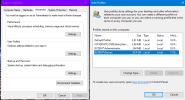I need to clone an MBR SATA boot drive to an NVME. So my usual process of cloning the drive and then booting the target drive and running mbr2gpt won't work.
Why don't you clone the disk first, then use the
MBR2GPT tool on the new NVMe SSD? You can install the NVMe disk in the target PC then run the tool offline from the command prompt on the
Windows Recovery USB flash drive (or a custom Windows ISO image prepared with
uupdump /
rufus). You can also run it on the technician's PC by booting into
Windows Preinstallation Environment (WinPE) image configured by WADK, or starting your existing Windows Recovery Environment.
If you run MBR2GPT in full OS mode, not in offline mode (i.e. WinPE, WinRE, or setup/recovery disk), do not convert the drive that you've just booted from, or the tool will create additional partitions instead of re-using the existing ones.
Personally I don't use MBR2GPT because it's unable to reconfigure the partitions to the
recommended GPT/UEFI layout of placing the EFI System Partition at the start of the disk, which can be a problem when you need to update the Windows Recovery Environment partition, as in that
botched KB5034441/ KB5034440 update.
What happens if mbr2gpt fails?
mbr2gpt has never failed on me but it would really suck to lose the original Windows install.
I suppose the only major point of failure for MBR2GPT would be an error creating and/or initializing the EFI System Partition and the BCD store - in that case, you will be left with a non-bootable GPT disk, but your Windows partition should be left intact, so you will have to setup ESP and BCD manually (according to my guide linked above

).
Though in-place conversion to GPT disk is also potentially risky, you should be able to rebuild the partition table with any decent 3rd party partitioning tool.
It seems from your instructions I could clone the drive, having the target set up as GPT and then manually create the EFI partition and stuff. Would that work?
Yes, it will - though the preferred way would be to first partition your new GPT disk according to
Microsoft recommended disk partition layout with their DiskPart sctipts, so that ESP is placed at the start of the disk, then copy only the Windows partition from the old disk using 3rd party disk/partition management software, and finally setup BCD store and WinRE image with
BCDBoot and
reagentc commands.
This would take less time than first cloning the entire disk, then non-destructively resizing the Windows partition to accomodate ESP at the beginning - which needs to relocate NTFS
system metafiles like MFT, cluster bitmap, boot record etc., recalculate all cluster chains for each file, and maybe move some data clusters, essentialy repeating most of the steps performed during disk cloning.
I guess I could clone the original drive to another SATA drive just to have an insurance policy
Making one more backup of your data is always a good idea. Learned my lesson through 4 failed hard disk drives that took countless valuable documents and photos with them.
